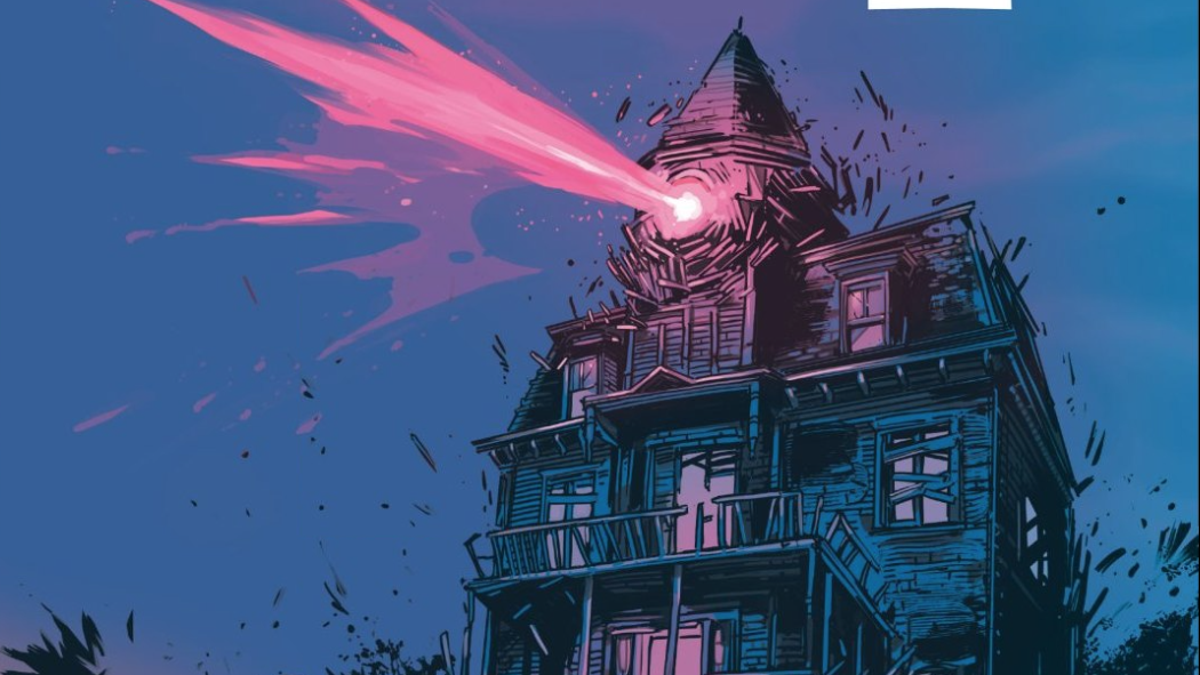Home Sick Pilots is the sort of comic that skillfully remixes influences and tropes without losing sight of what makes each of them compelling. Though the aesthetics don’t exactly scream gothic horror, the book is part of a long history of stories about women and haunted places, continuing the legacy of writers like Shirley Jackson. With just enough The Haunting Of Hill House flavor to be genuinely chilling (and a dash of 13 Ghosts for violence), Home Sick Pilots adds comedic beats from the likes of The Goonies or early seasons of Buffy The Vampire Slayer, pitting a group of mid-’90s teen punks against a haunted house and shaking the whole thing up until the pressure is set to pop.
The first volume of Home Sick Pilots collects the initial five issues and ends on a note that heralds big things to come in the sixth, out next month. The protagonist, Ami, is a member of the titular punk band, and though the comic isn’t exclusively about punk, it’s clearly influenced by the music of the era and the changes that punk was sometimes reluctantly going through, as bigots and gatekeepers tried to limit who was allowed to call themselves punk. While scouting for a spot to host a show, Ami enters a house with a reputation for being haunted—and quickly discovers it’s a lot more haunted than even the believers know.
It would be easy for the creative team to simply tell a good story about finding and fighting ghosts, and the high body count in the first few issues indicates it might have gone that way. But very quickly the story gains real heft by diving into the past. There’s a lot of trauma trapped in the history of both the girl and the house, containing deep feelings of abandonment. Combing through all of that is hard, and Ami is quickly absorbed into the mission of making the house whole again. Her friends and bandmates struggle with what to do in the face of her disappearance, and the book tackles difficult questions about mental health that make it a more compelling read than if it had simply been a ghost story. Ami and the other teens have slipped through so many cracks, and been let down by so many people, that it’s no surprise some of them are willing to reject society outright, while others are eager to attach themselves to people and things that may not have their best interests at heart.
On top of a solid story, Home Sick Pilots is a visual joy to behold. Artist Caspar Wijngaard has worked with Dan Watters on Limbo and with Simon Spurrier on Angelic, and his skill continues to grow. The designs for each of the ghosts are remarkable and communicate so much, while Ami’s evolving clothing and hair choices are quieter but no less important changes. Wijngaard did all of his own colors for this book, drenching it in rich pinks and blues that act as a great background for dark moments of horror (and occasionally an immense amount of blood). There are are a couple of double-page spreads that show a cross section of the whole house, each one unexpected and powerful. Dialogue and expository text are sparse, which highlights Aditya Bidikar’s crisp lettering. There’s a particular moment in the first few pages of the volume that’s truly laugh-out-loud funny, thanks in no small part to Bidikar’s work.
Taken at face value, Home Sick Pilots’ focus on the adventure that Ami and her friends go on as they learn about the ghosts is a good read. But the art, along with the careful way the creative team weaves further emotional depth into the backstory and the choices each character makes, elevate it far past that. Home Sick Pilots is for fans of gothic horror, Paper Girls, and Neon Genesis Evangelion—stories where young people are left behind by those who should have cared, pushed far past their breaking point, and forced to grapple with what that means.






More Stories
NEW Becki Owens Holiday Decor Collection – Becki Owens Blog
Top 5 Christmas styling tips to make holiday hosting easy
Top 10 Reasons To Move To Middleboro, MA